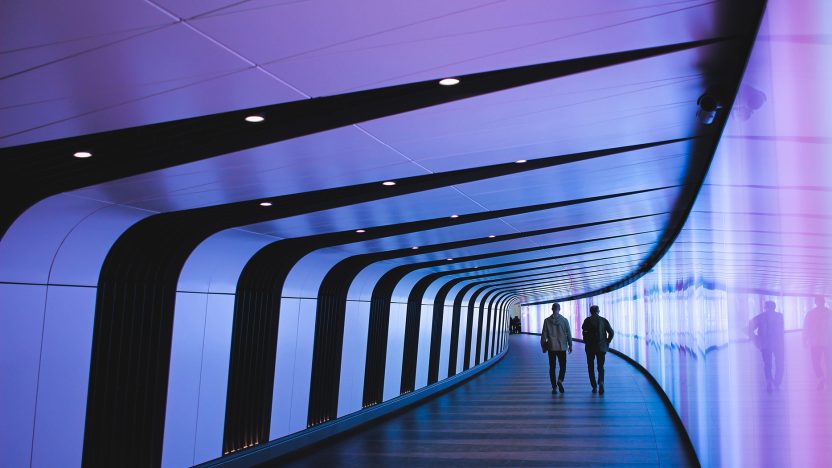Finding work’s new normal
Working from home puts a spotlight on what isn't working, while creating space for innovative forms of collaboration.
by Maks Giordano

Maks Giordano is a digital strategist, creative, and futurist with 25+ years in digital. He has worked with Apple, LEGO, Lufthansa, Daimler, and many others, and led innovation projects during the dot.com bust of 2001 and financial crisis of 2008.
Winston Churchill said: “Never let a good crisis go to waste.” How does that apply to the workplace in the Covid-19 world and the “New Normal” post Covid-19?
I like to look for the positive within the current crisis. There are clearly some companies who will struggle for a long time and need to re-invent parts of their business model (the travel and automotive industries), while others will hugely benefit from the “new normal” (e-commerce and collaborative software) and some new companies will be founded in these times of the crisis because they will identify something that the world needs right now.
In a workplace context the current situation of ‘work-from-home’ puts a huge spotlight on the elements that currently are not optimal – is our IT infrastructure modern enough to cope with remote work? Do we have the right tools and methods in place? Is our communication — and product development environment — working in a virtual setting? Is our mindset agile enough to come up with new strategies in PR, marketing, sales, etc. on short notice?
As individuals, we are forced to do things differently all of a sudden, like video conferencing, virtual team meetings, etc. We start to realize what is possible to achieve within a remote setting. We accept certain things about work-from-home and others we desperately miss, e.g. I keep hearing “I’m looking forward to being back in a meeting room and having a ‘proper’ brainstorming. I’m really looking forward to having quality time with colleagues. I miss the serendipity moments in the kitchen with my colleagues,” etc.
But even if we go back to a “New Normal,” many people will stick with habits from during the pandemic and realize, “hey, wait a second, that ain’t that bad.” Many people are getting accustomed to many positive elements like less travel — I haven’t heard one person say: “I miss business travel, or my commute to work so much.”
Is it possible that in the “New Normal” companies will be more intentional about face-to-face meetings?
I think it will come with a trade off. People will reevaluate, when do I really need that meeting and the travel? Does the sales meeting really need face-time or is it possible via a video call? Do we need the team in a meeting room or is a web meeting “good enough”? I expect a lot less business travel and fewer face-to-face meetings. Probably 9 out of 10 meetings can be done virtually and it comes with an advantage to do it virtually.
We will be super selective and choose physical meetings only when we need to see the body language or “creative energy” in the room for a brainstorming or co-creation workshop. In an HR leadership skills set development environment we will go back to physical meetings to have more inspiration, creativity, networking, and team-building in the room.
I have friends in Berlin who started doing walking meetings. Because it still feels really weird to currently push a doorbell to an office and enter a meeting room. But you can do a walking meeting and keep a little bit of distance and still interact with a real person, and see their body language and micro emotions.
Successful creative collaboration is definitely possible online when you’re very disciplined, adopt the process of a virtual environment (e.g. shorter time periods, virtual breaks, higher interactivity, etc.) and use software tools like Mural, Howspace, Klaxoon, or Miro.
For me, the ‘New Normal’ in my creative work will be a mix between virtual and physical formats. Some parts of the process can be done with remote teams in a virtual environment and other parts will hugely benefit from being back in a creative environment with great people.
How are companies trying to mimic the creative process virtually. And what are the limitations?
Imagine this pandemic 20 years ago, it would have been a disaster without that technology that allows us to work remotely.
But in 2020, we have these environments where you can collaborate virtually — there are tons of visually collaborative software tools and we learned to work iteratively, agilely, and with remote teams and team members. If your virtual workshop has to be a larger group, then you definitely need virtual breakout rooms and to work in smaller teams. I recommend limiting it to a maximum of five per breakout. Also make sure to adjust your process to the new virtual setting. I would aim for 2/3 of the regular time, say usually something takes up to 60 minutes in an agenda — make it 40 minutes. Take your virtual breaks. Make it highly interactive. Check back with the virtual audience regularly. Use visual feedback, e.g. with menti.com.
One thing that we miss out on virtually is picking up the energy in a room. That’s really hard in a virtual environment. It’s not black and white. If having the creative juices flowing in a nice meeting room is pure magic and if that’s 100 percent, virtual is not zero percent. It’s somewhere in between: You can write your virtual post-it and you can see what the others are writing, but there is simply a bit missing — that magic energy is almost impossible to recreate virtually.
So does that mean that during this time the creativity of certain companies might be stifled?
Going back to the Churchill quote, great ideas come from real problems —they are often developed when you identify a pain point, something that is not going well. So it also creates a lot of entrepreneurial moments. I’m really sure a lot of great companies will be born out of the crisis because they identified a problem and now they’re looking for a solution. But we still need these kinds of serendipity moments, these personal interactions where ideas are born, as well as team building. Companies need to think about this and if they think hard about it, they will come up with something that works for them. Maybe software tools where people can stick virtual notes up about what they’re currently passionate about, and then interact around those ideas. Perhaps virtual lunch meetings with a randomly assigned colleague. Or, you have inspiration moments delivered virtually. We can recreate serendipity moments, even online.
Are you saying that in the “New Normal” workplace we need to digitally replicate on-boarding, team building, and community?
Yes, this must also be possible in the virtual realm — let’s call it a passion for detail: Zoom backgrounds, a distinctive coffee mug, quality headsets, a PDF or a course with tools and tips for making working at home more efficient, and an online yoga meditation. Management should check in with their team regularly, have virtual coffee breaks together, host virtual team events, etc.
I’ve seen examples of virtual team meetings in game environments, playing Minecraft together or hanging out at a virtual campfire within the Red Dead Redemption game.
For me, this lockdown, it’s a big amplifier. It pinpoints bad leadership and bad tools, but also great leadership and caring, being compassionate about others, and being a resilient leader. This type of leader, who says, first of all: We are safe. We are healthy. We are at home with our families and loved ones. We have our jobs, and what can we do to survive these coming weeks? What are the positive things? And most importantly, what new opportunities can we seize from this situation?


